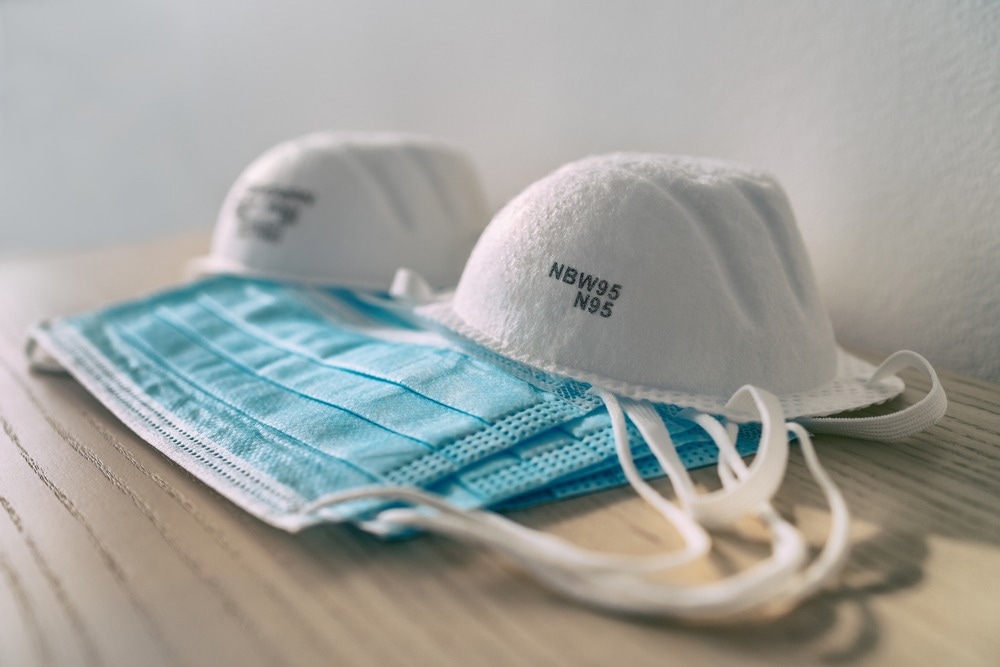 By Neha MathurReviewed by Danielle Ellis, B.Sc.Dec 1 2022
By Neha MathurReviewed by Danielle Ellis, B.Sc.Dec 1 2022In a recent article published in ACP Journals, researchers determined whether medical (surgical) masks were non-inferior to N95 respirators in preventing a severe acute respiratory syndrome coronavirus 2 (SARS-CoV-2) infection in healthcare workers (HCWs).
 Study: Medical Masks Versus N95 Respirators for Preventing COVID-19 Among Health Care Workers. Image Credit: Maridav/Shutterstock
Study: Medical Masks Versus N95 Respirators for Preventing COVID-19 Among Health Care Workers. Image Credit: Maridav/Shutterstock
Background
Surgical masks or N95 respirators are a component of all HCWs personal protective equipment (PPE). The World Health Organization (WHO) recommends medical masks for HCWs involved in the routine care of coronavirus disease 2019 (COVID-19) patients. On the other hand, the Centers for Disease Control and Prevention recommends N95 respirators for these HCWs. Yet, it remains unknown whether both these offer similar protection against COVID-19.
Previous meta-analyses of randomized clinical trials (RCTs) for other respiratory viruses suggested that surgical masks and N95 respirators offered similar protection. However, it is plausible that self-reported results and potential recall biases might have limited their findings.
It is noteworthy that N95 respirators are tested for fit and provide better filtration than surgical masks. However, their insufficient supplies globally during the pandemic, because of their high costs, is a concern for the HCW community.
About the study
The researchers hypothesized that surgical masks would be non-inferior to N95 respirators. In the present multicenter, non-inferiority RCT, they screened 29 healthcare centers in Canada, Pakistan, Egypt, and Israel between 4 May 2020 and 29 March 2022. The 1009 HCWs who enrolled in the study provided direct care to patients with COVID-19, confirmed via positive reports of a reverse transcription-polymerase chain reaction (RT-PCR) test.
Most study participants were unvaccinated nurses; however, the team included other HCWs later to increase the number of participants in this trial. They also decreased the time to follow-up from 12 to 10 weeks to reduce lack of follow-up. Further, they retained participants who received a single dose of a COVID-19 vaccine after enrollment and followed up with them for two weeks after their first dose.
The present RCT eventually had a variable follow-up time and used the non-inferiority margin to compute the hazard ratios (HRs). Notably, the researchers assigned all trial participants to medical masks or N95 respirator groups in a 1:1 ratio using a computerized randomized scheme, further stratified by the participating center in permuted blocks of four.
The participants self-reported the extent to which they used the assigned mask (surgical or N95 respirator) weekly. Besides, they all adhered to their institutional policies regarding discarding masks. The primary study outcome was a SARS-CoV-2-confirmed RT-PCR test from the date of randomization until the end of follow-up. However, the team also looked for serological evidence(s) of infection, such as acute respiratory illness, pneumonia, etc.
The team also audited trial participants to ensure strict adherence to the intervention. To this end, the coordinating center randomly selected 20% of shifts at a participating healthcare facility to observe trial participants. Finally, the researchers used a Cox proportional hazards model stratified by healthcare facilities to estimate HR and corresponding two-sided 95% confidence intervals (CIs).
Study findings
Of 1,009 enrolled RCT participants, the team randomly assigned 500 individuals to the medical masks and N95 respirator groups. There were 268, 34, 187, and 520 participants from Canada, Israel, Pakistan, and Egypt, respectively, with balanced and almost similar baseline characteristics within each country. However, seropositivity at baseline varied by country, with the highest seropositivity of 81% observed in Egypt. The average duration of follow-up was 9.06 weeks and 9.03 weeks in the surgical mask group and N95 respirator group, respectively.
RT-PCR–confirmed COVID-19 occurred in 52/497 and 47/507 participants in the medical mask group versus the N95 respirator group (10.46% vs. 9.27%), with HR equal to 1.14. The two groups reported 47 and 59 (10.8% vs. 13.6%) adverse events related to the intervention, respectively.
Country-wise unplanned subgroup analysis uncovered that variable proportions of HCWs were RT-PCR–confirmed COVID-19 positive in both groups. For instance, RT-PCR–confirmed COVID-19 occurred in Canada in 8/131 and 3/135 individuals in the medical mask group vs. the N95 respirator groups, respectively, with HR=2.83. The incidence of RT-PCR–confirmed COVID-19 for Isreal, Pakistan, and Egypt were 6/17 vs. 4/17 (HR, 1.54), 3/92 vs. 2/94 (HR, 1.50), and 35/257 vs. 38/261 (HR, 0.95), respectively.
Conclusions
The study demonstrated country-level heterogeneity in the RT-PCR positivity and baseline seropositivity rates. Though the pooled CI estimate for preventing RT-PCR–confirmed COVID-19 for surgical masks was within the non-inferiority margin of two, this margin was wide compared with N95 respirators. A possible explanation could be that while the study enrollment in Canada occurred early during the pandemic, the same was done later in Pakistan and Egypt when people had already contracted COVID-19 at least once and received vaccines.
Over 50% of the trial participants were enrolled from Egypt when Omicron was circulating. Thus, the researchers noted a null effect of surgical masks relative to N95 respirators in Egypt. One reason could be that higher community transmission in Egypt obscured the higher number of Omicron infections associated with the use of surgical masks vs. the N95 respirator, a finding contrasting with what the researchers observed in Canada.
Nevertheless, country-wise subgroup estimates varied, and even overall estimates remain inapplicable to individual countries due to treatment effect heterogeneity. The study results, however, pointed at twice the hazard of RT-PCR–confirmed COVID-19 in HCWs providing routine care to COVID-19 patients and using surgical masks vs. those using N95 respirators.